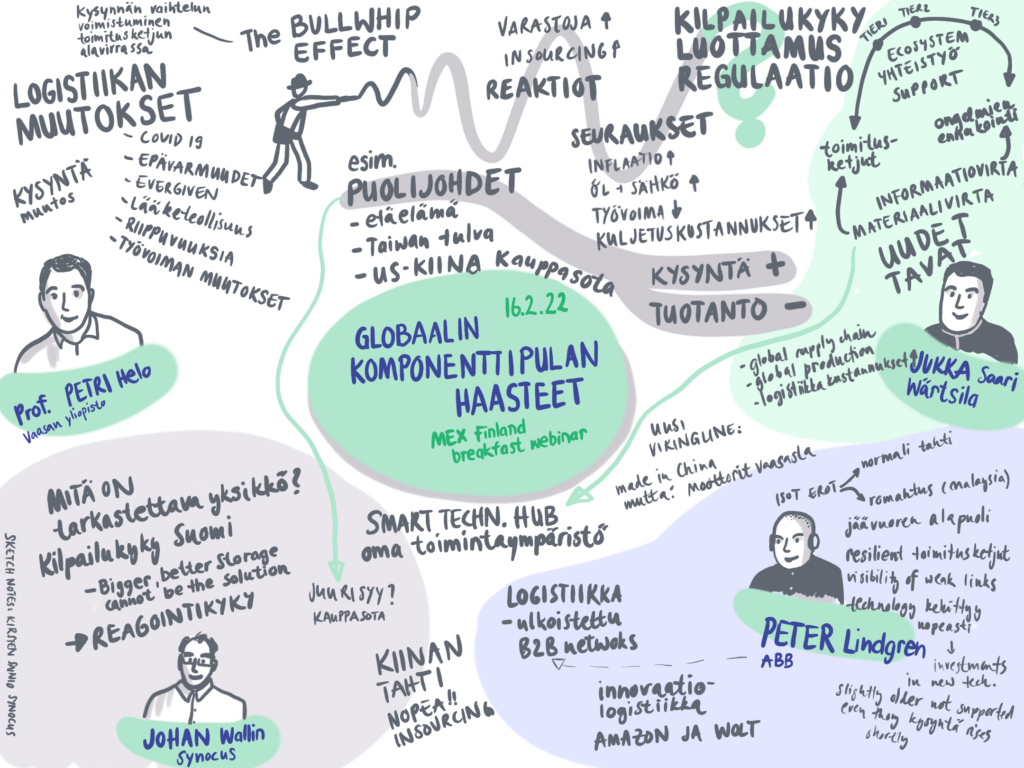24 February 2022
“Challenges of the global component shortage” – MEX Finland hosted a breakfast webinar on Wednesday, February 16th, 8:00-9:00.
About 50 participants tuned in early Wednesday morning to join us in a webinar on the “Challenges of the global component shortage”.
Our keynote speaker Professor Petri Helo of the University of Vaasa showed us how component shortages are linked with other global trends. Covid-19 fueled the uncertainties in global supply chains at the beginning of the pandemic now two years ago. Weak links in the supply chains became visible, like the blocking of the Suez Canal by the Ever Given in March 2021. Workforce changes and shortages were not only caused by sick leaves, quarantines, and public measures but also due to Brexit and travel bans. Immediate impacts were seen for example in food supply where acute disruptions were experienced locally but usually only for short periods.
In the case of semiconductors, the drivers for shortages were different. A sudden demand due to increased remote work and use of digital services could not be supplied because production sites had been closed due to the pandemic, in the case of Taiwan they were closed due to flooding. The trade war between the US and China did influence the supply of semiconductors as well. The development and production timeline for semi-conductors can take from 4-6 years so the short supply can well last a while longer.
Generally, it became clear that companies have rather poor visibility into their supply base, usually not going beyond the second tier. In reaction, storage facilities and in-sourcing were increased. Overall, the factors for rising shipping costs have been influenced by the costs of oil and electricity, inflation, and workforce changes. Petri Helo finished his talk with three themes open for discussion: competitiveness, trust, and regulation.
Jukka Saari of Wärtsilä shared his view of the global supply chain challenges during the last two years. As a manufacturing company, the work that can be done remotely is limited. And while Wärtsilä had no problems with delivery times to their own clients, the surrounding challenges have triggered some concern about the apparent vulnerability of global supply chains. As a preventive measure, new modes of operation were formed mainly around material flows and information flows. The communication and sharing of information down the supply chain foster teamwork and a systemic openness within the partner community. This supports forecasting and decision-making processes more effectively. The overall cost of logistics has risen but Wärtsilä benefited from their production lines in the EU and Asia by using dual sourcing from their local supply chains and material streams within the company.
Peter Lindgren of ABB looked back at the pandemic years and reminded us that there are big differences in the impact of the pandemic, some countries have suffered a great deal, and some have just almost continued as usual. In his opinion, all the extraordinary difficulties of the last two years were only the tip of the iceberg. The bigger part under the surface, the reason why this is a problem, that will last a while longer has to be geopolitical. Over time we had developed very long supply chains and highly on-demand operations with super-optimized storage facilities, and, therefore, a seemingly small incident in the Suez Canal has such wide consequences. In relation to the example of semiconductor shortages that Petri Helo mentioned, Peter Lindgren mentioned one more reason adding to the shortage. The continuously fast-evolving development of technology consumer goods. Investments only ever focus on the newest technology available. A sudden high demand for today’s product will stay unanswered, simply because the industry is not prepared to manufacture yesterday’s components.
Johan Wallin of Synocus questioned if competitiveness can be reduced to company operations or whether we should regard it as a national challenge and whether the collaborations between the manufacturing industry and logistics could be intensified through MEX Finland. In response, Jukka Saari stressed the point, that from a manufacturing business point of view the operations have been optimized to the point that real competitiveness can only be achieved by opening towards the ecosystem, which Wärtsilä is actively pursuing with the Smart Technology Hub in Vaasa. Peter Lindgren promoted the importance of B2B logistics where the biggest innovators have been companies like Amazon and Wolt. Their successes have been inspiring and should be discussed also for the manufacturing industry.
This was the first in a series of morning webinars designed to support the collaboration between MEX Finland members and encourage dialogue on interesting topics. While the time for further discussion was unfortunately cut short, we had a very inspiring morning and look forward to the next webinar in March. Stay tuned for more information.
Mex Finland is preparing new initiatives together with the Intralogistixx network. Resilient Materials is a project with MEX Finland member Sacometal that explores material flows. If you are interested in these themes, please contact Niklas Koski.
